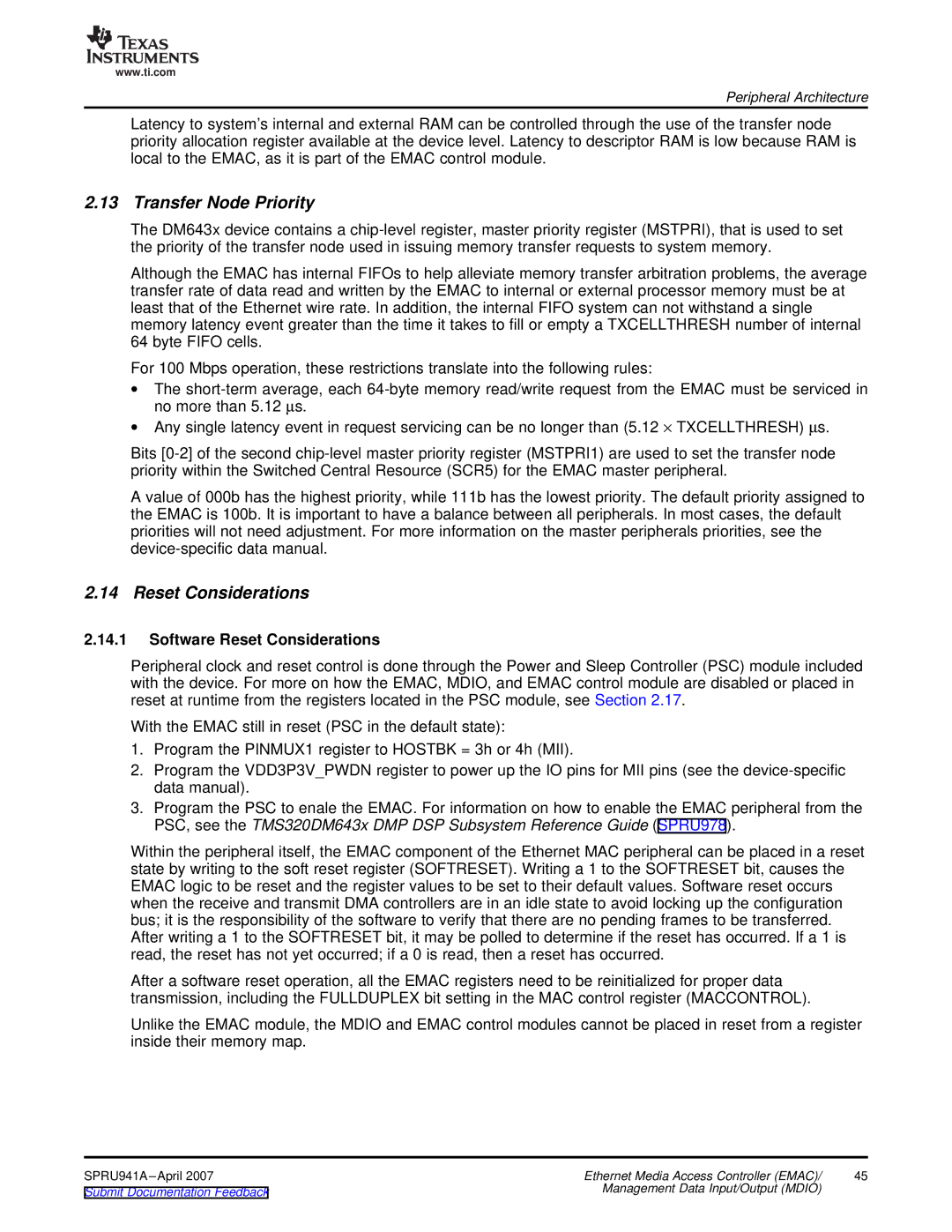
www.ti.com
Peripheral Architecture
Latency to system’s internal and external RAM can be controlled through the use of the transfer node priority allocation register available at the device level. Latency to descriptor RAM is low because RAM is local to the EMAC, as it is part of the EMAC control module.
2.13 Transfer Node Priority
The DM643x device contains a
Although the EMAC has internal FIFOs to help alleviate memory transfer arbitration problems, the average transfer rate of data read and written by the EMAC to internal or external processor memory must be at least that of the Ethernet wire rate. In addition, the internal FIFO system can not withstand a single memory latency event greater than the time it takes to fill or empty a TXCELLTHRESH number of internal 64 byte FIFO cells.
For 100 Mbps operation, these restrictions translate into the following rules:
∙The
∙Any single latency event in request servicing can be no longer than (5.12 × TXCELLTHRESH) μs.
Bits
A value of 000b has the highest priority, while 111b has the lowest priority. The default priority assigned to the EMAC is 100b. It is important to have a balance between all peripherals. In most cases, the default priorities will not need adjustment. For more information on the master peripherals priorities, see the
2.14 Reset Considerations
2.14.1Software Reset Considerations
Peripheral clock and reset control is done through the Power and Sleep Controller (PSC) module included with the device. For more on how the EMAC, MDIO, and EMAC control module are disabled or placed in reset at runtime from the registers located in the PSC module, see Section 2.17.
With the EMAC still in reset (PSC in the default state):
1.Program the PINMUX1 register to HOSTBK = 3h or 4h (MII).
2.Program the VDD3P3V_PWDN register to power up the IO pins for MII pins (see the
3.Program the PSC to enale the EMAC. For information on how to enable the EMAC peripheral from the PSC, see the TMS320DM643x DMP DSP Subsystem Reference Guide (SPRU978).
Within the peripheral itself, the EMAC component of the Ethernet MAC peripheral can be placed in a reset state by writing to the soft reset register (SOFTRESET). Writing a 1 to the SOFTRESET bit, causes the EMAC logic to be reset and the register values to be set to their default values. Software reset occurs when the receive and transmit DMA controllers are in an idle state to avoid locking up the configuration bus; it is the responsibility of the software to verify that there are no pending frames to be transferred. After writing a 1 to the SOFTRESET bit, it may be polled to determine if the reset has occurred. If a 1 is read, the reset has not yet occurred; if a 0 is read, then a reset has occurred.
After a software reset operation, all the EMAC registers need to be reinitialized for proper data transmission, including the FULLDUPLEX bit setting in the MAC control register (MACCONTROL).
Unlike the EMAC module, the MDIO and EMAC control modules cannot be placed in reset from a register inside their memory map.
SPRU941A
Submit Documentation Feedback | Management Data Input/Output (MDIO) |
|
